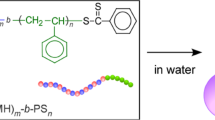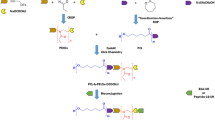Abstract
Oligomers of 2-methyl nylon3 (2mN3) and 3-methyl nylon3 (3mN3) were synthesized by base-catalyzed hydrogen transfer polymerization (HTP) of methacrylamide and crotonamide, respectively. The detailed structural analyses of 2mN3 and 3mN3 were performed using MALDI-MS, 1H-NMR, elemental analysis and several end-group analyses to ascertain polymerization mechanism and exact chemical structures of final products. The structural analyses revealed that (1) base-catalyzed HTP of methacrylamide and crotonamide follows the sequence of: hydrogen abstraction from amide group of monomer by basic catalyst (NatBuO), addition of monomeric units to the anionic center, intramolecular hydrogen migration and finally, termination by hydrogen transfer from protonated catalyst (tBuOH) to anionic end-group, (2) both oligomeric products have olefinic chain-ends resulting from the initiation mechanism. The specific behavior of basic catalyst leads to the formation of olefinic chain-ends that are apt to possible end-group functionalization. Since the functional end-groups of a well-defined macromonomer are of importance in terms of chain extension, grafting, chemical modification, click chemistry, monolayer surface modification, etc., it was aimed to create more reactive functional end-groups by epoxylation and bromination. Disappearance of the signals belonging to the olefinic protons in 1H-NMR spectra of modified oligomers and existence of bromine and epoxy adducts in MALDI MS spectra of the modified oligomers were attributed to end-group modification as intended. Hence, four novel macromonomers of polyamidic backbone with functional chain-ends were synthesized successfully.









Similar content being viewed by others
References
Masamoto J, Sasguri K, Ohizumi C, Yamaguchi K, Kobayashi H (1970) A new synthetic fiber made of nylon3. J Appl Polym Sci 14:667–680
Masamoto J (2000) Nylon3. Rep Prog Polym Phys Jpn 43:867–876
Yamamoto F, Misumi T (1991) Preparation of poly-β-alanine from acrylamide. US Pat. 5,015,707 assigned to Asahi Chemical
Graf R, Lohaus G, Borner K, Schmidt E, Bestian H (1962) β-Lactams, their polymerization and use as raw materials for fibers. Angew Chem Int Ed Engl 1:481–488
Breslow DS, Hulse GE, Matlack AS (1957) Synthesis of poly-β-alanine from acrylamide. A novel synthesis of β-alanine. J Am Chem Soc 79:3760–3763
Otsu T, Yamada B, İtahashi M, Mori T (1976) Hydrogen transfer polymerization of methyl substituted acrylamides. J Polym Sci Polym Chem Ed 14:1347–1361
Yamaguchi K, Minoura Y (1972) Hydrogen-transfer polymerization of acrylamide and methacrylamide with optically active basic catalysts. J Polym Sci 10:1217–1231
Guaita M, Thomas LF (1968) High resolution NMR investigation of poly(β-alanine) and poly(α-methyl-β-alanine). Makromolekul Chem 119:113–121
Kobuke Y, Hanji K, Fukurawa J (1971) Hydrogen transfer polymerization of cis- and trans-crotonamides. J Polym Sci 9:431–440
Eisenbach CD, Lenz RW, Duval M, Marchessault RH (1979) Polymerization of α, α-disubstituted β-propiolactones and lactams, 12. Properties and crystalline structure of poly(β-propiolactam)s. Makromolekul Chem 180:429–440
Wexler H (1968) Migrational polymerization of methacrylamide. Makromolekul Chem 115:262–267
Schmidt E (1970) Über optisch aktive poly-β-amide. Angew Macromol Chem 14:185–202
Tan I, Zarafshani Z, Lutz JF, Titirici MM (2009) PEGylated chromatography: efficient bioseparation on silica monoliths grafted with smart biocompatible polymers. ACS Appl Mater Interfaces 1(9):1869–1872
Goddard JM, Hotchkiss JH (2007) Polymer surface modification for the attachment of bioactive compounds. Prog Polym Sci 32:698–725
Lemechko P, Renard E, Volet G, Colin CS, Guezennec J, Langlois V (2012) Functionalized oligoesters from poly(3-hydroxyalkanoate)s containing reactive end group for click chemistry: Application to novel copolymer synthesis with poly(2-methyl-2-oxazoline). React Funct Polym 72:160–167
Fray ME, Skrobot J, Bolikal D, Kohn J (2012) Synthesis and characterization of telechelic macromers containing fatty acid derivatives. React Funct Polym 72:781–790
Thompson MS, Vadala TP, Vadala ML, Lin Y, Riffle JS (2008) Synthesis and applications of heterobifunctional poly(ethylene oxide) oligomers. Polymer 49:345–373
Masamoto J, Sasguri K, Ohizumi C, Kobayashi H (1970) Polymorphic forms of nylon3. J Polym Sci 8:1703–1711
Yasuda M (1931) Determination of iodine numbers of some lipids. J Biochem 94:401–409
Ogata N (1960) The transition polymerization of acrylamide. Part II. On the reaction mechanism. Makromol Chem 40:55–63
Tani H, Oguni N, Araki T (1963) Initiation reaction in the strong base catalyzed polymerization of acrylamide. Makromol Chem 76:82–88
Haldar U, Ramakrishnan L, Sivaprakasam K, De P (2014) Main-chain sulphur containing water soluble poly(N-isopropylacrylamide-co-N,N′-dimethylacrylamide sulphide) copolymers via interfacial polycondensation. Polymer 55:5656–5664
Ballard N, Salsamendi M, Santos JI, Ruipérez F, Leiza JR, Asua JM (2014) Experimental evidence shedding light on the origin of the reduction of branching of acrylates in ATRP. Macromolecules 47:964–972
Parent EE, Dence CS, Jenks C, Sharp TL, Welch MJ, Katzenellenbogen JA (2007) Synthesis and biological evaluation of [18F] bicalutamide, 4-[76Br] bromobicalutamide, and 4-[76Br] bromo-thiobicalutamide as non-steroidal androgens for prostate cancer imaging. J Med Chem 50:1028–1040
Tong KH, Wong KY, Chan TH (2003) Manganese/bicarbonate-catalyzed epoxidation of lipophilic alkenes with hydrogen peroxide in ionic liquids. Org Lett 5:3423–3425
de Gooijer JM, Scheltus M, Koning LE (2004) End group modification of polyamide-6 in supercritical and subcritical fluids: Part 2: Amine and carboxylic acid end group modification with 1,2-epoxybutane. J Supercrit Fluids 29:153–164
Sugi R, Yokohama A, Yokozawa T (2003) Synthesis of well-defined telechelic aromatic polyamides by chain-growth polycondensation: application to the synthesis of block copolymers of polyamide and poly(tetrahydrofuran). Macromol Rapid Commun 24:1085–1090
Hossainy SFA (2004) Rotary coating apparatus for coating implantable medical devices. US Patent 6.709.514 B1
Facetti SD (2008) Biobeneficial polyamide/polyethylene glycol polymers for use with drug eluting stents. US Patent 7.435.788 B2
Stuparu CM, Khan A (2016) Thiol-epoxy “click” chemistry: application in preparation and postpolymerization modification of polymers. J Poylm Sci Part A Polym Chem 54:3057–3070
Acknowledgements
The authors wish to thank Dr. Mehmet Atakay for the MALDI mass measurements.
Author information
Authors and Affiliations
Corresponding author
Rights and permissions
About this article
Cite this article
Çatıker, E., Güven, O. & Salih, B. Novel hydrophobic macromonomers for potential amphiphilic block copolymers. Polym. Bull. 75, 47–60 (2018). https://doi.org/10.1007/s00289-017-2014-2
Received:
Revised:
Accepted:
Published:
Issue Date:
DOI: https://doi.org/10.1007/s00289-017-2014-2




